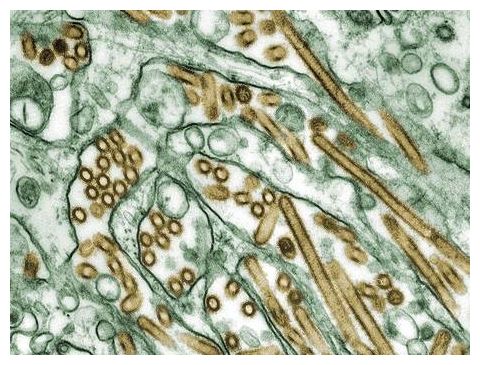
© The Independent, UK
A mysterious group of viruses known for their circular genome has been detected in patients with severe disease on two continents. In papers published independently this week, researchers report the discovery of agents called cycloviruses in Vietnam and in Malawi. The studies suggest that the viruses - one of which also widely circulates in animals in Vietnam - could be involved in brain inflammation and paraplegia, but further studies are needed to confirm a causative link.
The discovery in Vietnam grew out of a frustrating lack of information about the causes of some central nervous system (CNS) infections such as encephalitis and meningitis, which can be fatal or leave lasting damage. "There are a lot of severe cases in the hospitals here, and very often we can't come to a diagnosis," says H. Rogier van Doorn, a clinical virologist with the Oxford University Clinical Research Unit in the Hospital for Tropical Diseases, Ho Chi Minh City. Extensive diagnostic tests turn up pathogens in only about half of patients with such infections, he says. Van Doorn and colleagues in Vietnam and at the University of Amsterdam's Academic Medical Center hoped that they might uncover new pathogens using a powerful new technique called next-generation sequencing.
The group sequenced all the genetic material in cerebrospinal fluid (CSF) samples taken from more than 100 patients with undiagnosed CNS infections. One sample batch returned a promising lead: a viral sequence belonging to the
Circoviridae family
.Probing the original patient samples, the scientists ferreted out the sequence in two of the samples - one from an adult and one from a child. Next, they expanded their search, testing samples from an additional 642 patients with CNS infections using a sensitive polymerase chain reaction (PCR) test developed to specifically target the detected sequence.
Roughly 4% of the samples tested positive, the team reported in
mBio on Tuesday. Whole-genome sequencing confirmed that the virus, which the scientists have dubbed CyCV-VN, for cyclovirus-Vietnam, is novel; it belongs to a genus within the
Circoviridae family called cycloviruses.
Meanwhile, a team at Erasmus MC in Rotterdam, the Netherlands, had been trying to determine what causes paraplegia in some patients in Malawi, in southeast Africa. It's well known that trauma and some infections can cause people to lose control over their legs, but in many cases, doctors can't find a cause. The Dutch team hunted for viruses in blood serum and CSF samples from 12 patients who had suddenly become paraplegic in 2010 and 2011. They found a new cyclovirus as well; when they tested for the virus in a broader group of 58 paraplegia patients,
they found it in 15% of 54 serum samples and 10% of 40 CSF samples, the team reports in a paper published online this week in
Emerging Infectious Diseases.
Cycloviruses were first discovered in 2009 - along with a host of other viruses -
in fecal samples from South-Asian children suffering from acute flaccid paralysis, by a team led by Eric Delwart of the Blood Systems Research Institute in San Francisco. Since then, they have also been found in human fecal samples from Nigeria and Tunisia, as well as in farm animals, chimpanzees, bats, cockroaches, and dragonflies. While the new viruses are related, says Le Van Tan, another member of the Vietnam team, initial comparisons of the genomes suggest that they form two new species.
Neither of the studies prove that the viruses cause disease, however, says Delwart, who was not involved in the new papers. In the Malawi study, researchers did not include a control group, so they don't know if healthy people carry the virus as well; in the Vietnam study, samples taken from a control group of 122 patients with noninfectious CNS conditions tested negative for the new virus. Still, other factors might explain that, Delwart says.
It's possible, Delwart says, that these viruses aggravate existing disease; 16 of the 26 people who carried the cyclovirus in the Vietnam study also had a lab-confirmed infection with another pathogen, such as Japanese encephalitis or dengue. "It may be: one virus, bad; two viruses, worse," he says.
Van Doorn says that the team is wary of speculating until more is known about CyCV-VN; the team is sharing its results "with the public and the scientific world so that more research can be initiated," he says.
To find out if the new viruses actually cause disease, researchers can try to grow them in cell culture and infect animals with them. Another critical task is to cast a wider net using a PCR test that can pick up related cycloviruses as well as CyCV-VN, Van Doorn says - which could help determine how entrenched cycloviruses are in the population. The Rotterdam group is also planning to look for the virus more broadly, says Saskia Smits, the first author on the paper.
The Vietnam study shed some light on how people may pick up the virus. Because other
Circoviridae are known animal pathogens, testing chickens, ducks, and pigs for CyCV-VN was the "obvious next step," Van Doorn says. The scientists checked fecal swabs taken from dozens of animals in Dong Thap province and found what the virologist calls "remarkably high" incidence of the virus: Nearly 60% of the animal samples tested positive. Moreover, the animal strains of CyCV-VN showed a 98% similarity to those isolated from humans. Because chickens, ducks, and pigs are "commonly held in Vietnam in backyards and on small farms," Van Doorn says, "there is a lot of possible contact between these viruses and humans."
Agent Orange can be the cause? Africans are extremely vaccinated, they received more vaccines than food or any help. And we know that Vietnamese have received agent orange like anybody else. So maybe the culprits are these two malevolent poisons? Or maybe something worse, because we know that Africa is a laboratory...